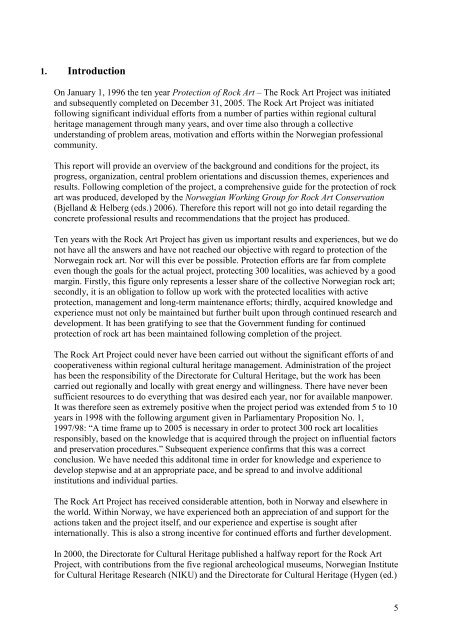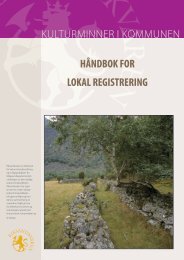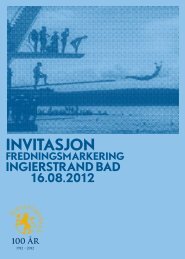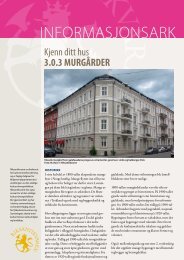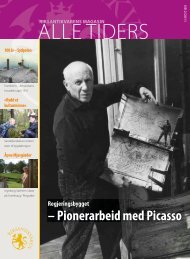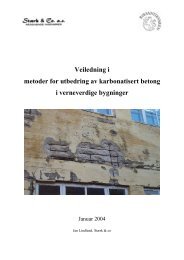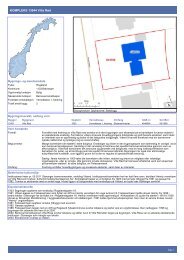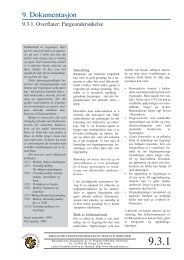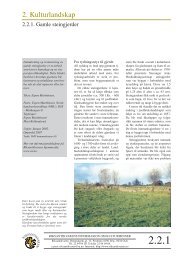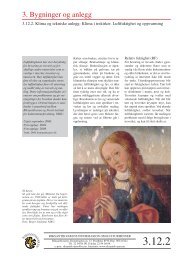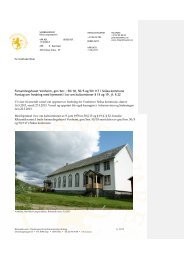Protection of Rock Art - Riksantikvaren
Protection of Rock Art - Riksantikvaren
Protection of Rock Art - Riksantikvaren
Create successful ePaper yourself
Turn your PDF publications into a flip-book with our unique Google optimized e-Paper software.
1. Introduction<br />
On January 1, 1996 the ten year <strong>Protection</strong> <strong>of</strong> <strong>Rock</strong> <strong>Art</strong> – The <strong>Rock</strong> <strong>Art</strong> Project was initiated<br />
and subsequently completed on December 31, 2005. The <strong>Rock</strong> <strong>Art</strong> Project was initiated<br />
following significant individual efforts from a number <strong>of</strong> parties within regional cultural<br />
heritage management through many years, and over time also through a collective<br />
understanding <strong>of</strong> problem areas, motivation and efforts within the Norwegian pr<strong>of</strong>essional<br />
community.<br />
This report will provide an overview <strong>of</strong> the background and conditions for the project, its<br />
progress, organization, central problem orientations and discussion themes, experiences and<br />
results. Following completion <strong>of</strong> the project, a comprehensive guide for the protection <strong>of</strong> rock<br />
art was produced, developed by the Norwegian Working Group for <strong>Rock</strong> <strong>Art</strong> Conservation<br />
(Bjelland & Helberg (eds.) 2006). Therefore this report will not go into detail regarding the<br />
concrete pr<strong>of</strong>essional results and recommendations that the project has produced.<br />
Ten years with the <strong>Rock</strong> <strong>Art</strong> Project has given us important results and experiences, but we do<br />
not have all the answers and have not reached our objective with regard to protection <strong>of</strong> the<br />
Norwegain rock art. Nor will this ever be possible. <strong>Protection</strong> efforts are far from complete<br />
even though the goals for the actual project, protecting 300 localities, was achieved by a good<br />
margin. Firstly, this figure only represents a lesser share <strong>of</strong> the collective Norwegian rock art;<br />
secondly, it is an obligation to follow up work with the protected localities with active<br />
protection, management and long-term maintenance efforts; thirdly, acquired knowledge and<br />
experience must not only be maintained but further built upon through continued research and<br />
development. It has been gratifying to see that the Government funding for continued<br />
protection <strong>of</strong> rock art has been maintained following completion <strong>of</strong> the project.<br />
The <strong>Rock</strong> <strong>Art</strong> Project could never have been carried out without the significant efforts <strong>of</strong> and<br />
cooperativeness within regional cultural heritage management. Administration <strong>of</strong> the project<br />
has been the responsibility <strong>of</strong> the Directorate for Cultural Heritage, but the work has been<br />
carried out regionally and locally with great energy and willingness. There have never been<br />
sufficient resources to do everything that was desired each year, nor for available manpower.<br />
It was therefore seen as extremely positive when the project period was extended from 5 to 10<br />
years in 1998 with the following argument given in Parliamentary Proposition No. 1,<br />
1997/98: “A time frame up to 2005 is necessary in order to protect 300 rock art localities<br />
responsibly, based on the knowledge that is acquired through the project on influential factors<br />
and preservation procedures.” Subsequent experience confirms that this was a correct<br />
conclusion. We have needed this additonal time in order for knowledge and experience to<br />
develop stepwise and at an appropriate pace, and be spread to and involve additional<br />
institutions and individual parties.<br />
The <strong>Rock</strong> <strong>Art</strong> Project has received considerable attention, both in Norway and elsewhere in<br />
the world. Within Norway, we have experienced both an appreciation <strong>of</strong> and support for the<br />
actions taken and the project itself, and our experience and expertise is sought after<br />
internationally. This is also a strong incentive for continued efforts and further development.<br />
In 2000, the Directorate for Cultural Heritage published a halfway report for the <strong>Rock</strong> <strong>Art</strong><br />
Project, with contributions from the five regional archeological museums, Norwegian Institute<br />
for Cultural Heritage Research (NIKU) and the Directorate for Cultural Heritage (Hygen (ed.)<br />
5


